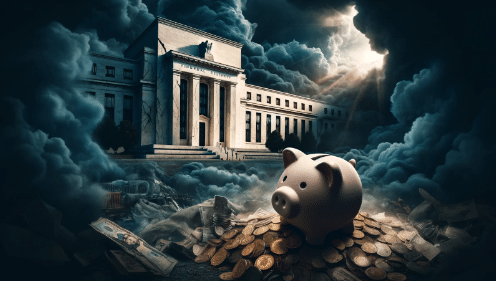
Oil Price Collapse Delivers a Loud Warning
“Biggest” or “fastest” declines in history are becoming routine characterizations in business media of everything from stocks to unemployment claims to U.S. Treasury yields and now to commodity prices. You’d have to go back to the 1930s and the Great Depression to find as many similar references.
And there was one other key characteristic that defined the early 1930s and now: unprecedented wealth inequality that had been manufactured by Wall Street running an institutionalized wealth transfer system that culminated in a stock market crash that erased 90 percent of the stock market’s value from 1929 to 1932.
The late MIT economist, Lester Thurow, explained some three decades ago what happens when wealth is concentrated in too few hands:
“Depression is seen as a product of systematic tendencies for the distribution of wealth to become concentrated among a few. When this happens, demand eventually sags relative to supply and long cyclical downturns commence…
“Essentially, the economic problem is like that of the wolf and the caribou. If the wolves eat all the caribou, the wolves also vanish. Conversely, if the wolves vanish, the caribou for a time multiply but eventually their numbers become too great and they die for lack of food. Producers need consumers, and if producers deprive workers of their fair share of production income they essentially deprive themselves of the affluent consumers they need to make their facilities profitable….”
Yesterday, the price of the front futures contract for U.S. domestic crude oil, known as West Texas Intermediate or WTI, closed in negative territory for the first time in history. The reason was that no one wanted to take physical possession of that crude oil because they could not find any place to store it. There is now such a global oversupply of crude that traditional storage places, like tankers and storage tanks, are full for the most part.
The May contract expires today and the price action in the new front month June contract does not look promising. At 9:25 a.m. this morning, the June contract was down by 29 percent with WTI trading at $14.50.
While the price action in crude yesterday was historic, it is far from the only commodity experiencing dramatic price declines.
On April 17, a devastating report was published in the Immokalee Bulletin titled “The Day South Florida Agriculture Died.” The report came from Gene McAvoy, associate director for stakeholder relations for the University of Florida IFAS Southwest Florida Research and Education Center and president of the National Association of County Agricultural Agents.
McAvoy described the situation as follows:
“On Tuesday, March 24, a local broker says, everything changed. From brokers, orders stopped and everything got quiet. On Wednesday, March 25, it got super quiet.
“Since then, tomato volumes are down 85%, green beans are like 50% and cabbage is like 50%.
“R.C. Hatton has plowed under 100 acres of green beans, around 2 million pounds, and 60 acres of cabbage, or 5 million pounds.
“Florida’s tomato growers target 80% of their production to restaurants and other food service companies, rather than to supermarkets. In this sector, growers are walking away from big portions of their crop.
“Tony DiMare estimates that by the end of the growing season, about 10 million pounds of his tomatoes will go unpicked.”
The demand destruction has also impacted cattle ranchers. The article notes that “The cash market and futures prices are lower than anyone can remember. One local rancher sold calves last week and averaged $250 per head at the Arcadia auction barn. A few weeks ago he would have received $450 per head average, and that constitutes below break-even.” That’s a 44 percent price decline.
Hog farmers are also facing a crisis. The Associated Press reported yesterday that “…almost overnight millions of hogs stacking up on farms now have little value.”
There is growing evidence that all of this demand destruction leading to collapsing prices cannot be blamed on the coronavirus outbreak. Treasury yields were plunging in August and September of last year, long before there was a coronavirus outbreak anywhere in the world. The Federal Reserve had to step in on September 17, 2019 – four months before the first coronavirus case in the U.S. – to shore up a liquidity crisis on Wall Street. The crisis was so bad that the Fed had to pump hundreds of billions of dollars weekly into the trading houses on Wall Street for months on end. (See the more than six dozen articles we penned on that topic from September 17 onward.)
U.S. manufacturing had already entered a recession in 2019 and the International Monetary Fund announced in October of 2019 that it was downgrading its global outlook and “predicted that growth in advanced economies would slow from 2.3% in 2018 to 1.7%” in 2019.
The U.S. had a previous warning of what causes this type of demand destruction. It is now known as the Great Financial Crisis of 2007 to 2010. The roots of that era of collapsing prices and today’s date back to November 12, 1999 when President Bill Clinton signed the Gramm-Leach-Bliley Act repealing the Glass-Steagall Act. Clinton’s signature on that legislation ended the 66-year long ban against Wall Street trading houses owning federally-insured banks holding the deposits of moms and pops across America.
Clinton released a statement on the signing of the Gramm-Leach-Bliley Act which said that the legislation would stimulate “greater innovation and competition in the financial services industry.” Today, just five Wall Street mega banks control the majority of assets of the more than 5,000 banks and savings associations that exist in the U.S. today. These same Wall Street banks are allowed to charge upwards of 17 percent or more on consumer credit cards while paying 1 percent or less to their depositors. Simply put, Clinton launched a massive wealth transfer system in America.
Clinton said this at the signing ceremony:
“The Gramm-Leach-Bliley Act makes the most important legislative changes to the structure of the U.S. financial system since the 1930s. Financial services firms will be authorized to conduct a wide range of financial activities, allowing them freedom to innovate in the new economy. The Act repeals provisions of the Glass-Steagall Act that, since the Great Depression, have restricted affiliations between banks and securities firms. It also amends the Bank Holding Company Act to remove restrictions on affiliations between banks and insurance companies. It grants banks significant new authority to conduct most newly authorized activities through financial subsidiaries. Removal of barriers to competition will enhance the stability of our financial services system.”
Nine years later, the U.S. financial system collapsed along with iconic, century old names on Wall Street as the U.S. entered the worst economic collapse since the Great Depression. This is round II.
Read Original Article at wallstreetonparade.com
The financial market is crumbling and EVERYONE will be affected. Only those who know what's going on and PREPARE will survive... dare we say thrive. Our 7 Simple Action Items to Protect Your Bank Account will give you the tools you need to make informed decisions to protect yourself and the ones you love.









